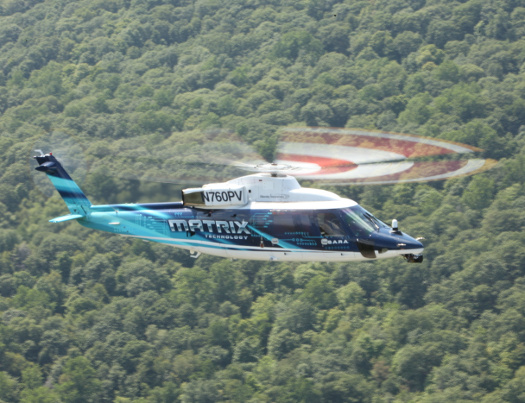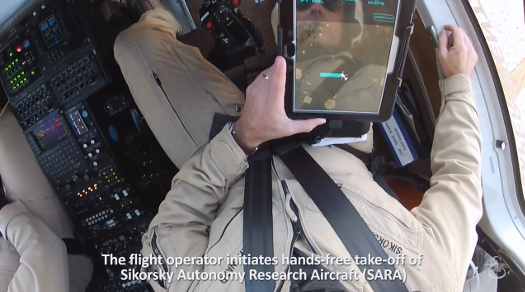 |
| June 14, 2016 | Volume 12 Issue 22 |
Designfax weekly eMagazine
Archives
Partners
Manufacturing Center
Product Spotlight
Modern Applications News
Metalworking Ideas For
Today's Job Shops
Tooling and Production
Strategies for large
metalworking plants
Wings: In an industry first, 30-mile helicopter flight piloted by tablet

Engineers and researchers at Sikorsky have been working for years to build and perfect advanced autonomous systems that can act as co-pilots on rotorcraft. On May 24, the company let the world know that it had taken its work one step farther by having the systems actually pilot a Sikorsky commercial helicopter on an extended mission, performing a completely autonomous 30-mile "click and fly" flight using a tablet computer for control.
The system directed the helicopter flight demonstrator from Sikorsky's Stratford, CT, facility to Robertson Airport in Plainville, CT, utilizing fully autonomous technology capabilities.

The work completed Phase 1 of an $8 million award from the Defense Advanced Research Projects Agency's (DARPA) Aircrew Labor In-Cockpit Automation System (ALIAS) program.
The flight highlighted the ability for an operator to plan and execute every phase of an autonomous mission with a tablet device. During the demonstration, a ground station crew located at the flight initiation field monitored the progress of the ALIAS-enabled Sikorsky Autonomy Research Aircraft (SARA), an S-76 commercial helicopter.
The ALIAS program envisions a customizable, drop-in, removable kit that would enable high levels of automation in existing aircraft and facilitate reduced need for onboard crew. The program intends to leverage the considerable advances that have been made in aircraft automation systems over the past 50 years, as well as the advances that have been made in remotely piloted aircraft technologies, to help shift and refocus pilot workloads, augment mission performance, and improve aircraft safety.
VIDEO: In this video, you can see a flight operator initiate a hands-free takeoff of the Sikorsky SARA aircraft, reposition the aircraft using touch and drag controls, and enter and confirm a flight path on a tablet computer. During takeoff, autonomous flight controls compensate for the wind to keep the helicopter stable.
Sikorsky's approach to ALIAS is based on its Matrix Technology, introduced in 2013 to develop, test, and field hardware and software systems that aim to significantly improve optionally piloted and piloted vertical take-off and landing (VTOL) aircraft. Sikorsky has installed MATRIX on both SARA and a BLACK HAWK helicopter.
An Aviation Week article about MATRIX back in 2013 stated at that time, "The company's approach is not to develop an autonomous vehicle, but an autonomy architecture that is platform-agnostic and can be used in manned, optionally piloted, and unmanned vehicles; inserted into the existing fleet and designed into future products; and incorporated into aircraft built by Sikorsky or its competitors, as a system or an ‘app.'"
But Sikorsky, working in conjunction with DARPA, has upped the ante as far as what the technology can do.
"With the advances we've made, the capability for safe, unobtrusive optionally piloted flight is here," said Mark Miller, vice president of Engineering & Technology at Sikorsky. "ALIAS is expanding the role of optionally piloted helicopters for early entry into established aircraft programs. It has the capability of not only reducing aircrew size, but also changing the type and length of training required for safe operation."
With work on ALIAS Phase 1 complete, Sikorsky has begun Phase 2 of the program. DARPA awarded Sikorsky a $9.8 million modification for the competition's second phase, which focuses on continued maturation of the initial ALIAS system with additional flight tests, enhancements to the human interface, and transition to additional aircraft to demonstrate ALIAS portability.
"The current environment limits the creation of new, optionally piloted platforms. What Sikorsky and DARPA are demonstrating is the successful and affordable integration of advanced technology onto existing legacy aircraft to not only set the stage for autonomous operations down the road, but also to immediately improve aircraft performance, reduce maintenance costs, and increase crew and passenger safety," said Chris Van Buiten, Vice President of Sikorsky Innovations, the technology research group for the Engineering & Technology organization.
The Sikorsky program has been building in new capabilities year after year.
The SARA demonstrator helicopter flew its first flight on July 26, 2013. In late 2013, it flew a full autonomous mission that demonstrated it could take off from an airport, fly a pattern, and return to the airport. The flight was done without sensors in the loop.
In 2014, the SARA research aircraft was outfitted with advanced multi-spectral sensors and high-performance computers that help it build a real-time virtual world of its surroundings and perform sensor-in-the-loop flight. Outfitted with fly-by-wire controls, it gained the ability to make site selection and landing with this new sensor equipment.
"The sensors allow her to fly at full speed, avoid obstacles, select landing zones, and do other tasks that are perceptually intensive," said Igor Cherepinsky, Chief Engineer for Sikorsky's Autonomy Program, back in 2014. "All of these are objectives of the Matrix Technology program as we move toward evolving SARA's abilities to understand and see the world in all sorts of conditions."
Using the spectral sensors, those conditions include adverse weather and air and ground effects, such as fog, smog, smoke, dust storms, and rain. Besides tracking direction, speed, and other basic flight parameters, the system's co-piloting capabilities are especially helpful in this context, taking care of monitoring conditions and providing "extra eyeballs" and a "helping hand" when conditions are challenging for human senses, especially to land or take off.
2015 saw the award of the $8 million DARPA contract for Phase 1 of the ALIAS program.
Matrix Technology is an architecture of software and hardware components, or "apps," that enable autonomous execution of complex missions in close proximity to obstacles at a new level of system reliability.
Designed to be platform independent, MATRIX technologies can be readily applied to benefit Sikorsky unpiloted or piloted vehicles as well as vehicles not originally designed by Sikorsky.
Matrix Technology addresses four fundamental challenges:
- Low-altitude, obstacle-rich autonomous flight;
- Multi-level contingency management to achieve a needed 100X improvement in levels of system reliability;
- A path to qualification or certification; and
- Lifecycle cost reduction.
A 2015 CBS News article said that by using the ALIAS technology, aircraft could also one day have pilot control switched midflight from the aircraft cockpit to a pilot on the ground should adverse conditions arise (pilot blackout, pilot being overwhelmed, hijacking, etc.). "Designers believe safeguards can be built into a digital co-pilot to stop a repeat of the Germanwings crash, where a lone pilot intentionally flew an airliner into the ground," the article stated.
Sikorsky did not respond to a Designfax request for information on the security of aircraft and network communications and connections.
The Matrix Technology program is led by Sikorsky Innovations, the same rapid prototyping organization that in 2010 proved the physics of efficient 250-knot flight in a rotorcraft with its X2 Technology Demonstrator program. Other teammates on the SARA project are United Technologies Research Center, the National Robotics Engineering Center, and Veloxiti, Inc.
Interestingly, when not in flight, the SARA test helicopter can be configured as its own simulator to develop and test autonomy software and hardware.
This is the second milestone reached this year for DARPA using ALIAS technology. In a totally different type of project, a research effort associated with DARPA's ALIAS program recently conducted the first successful flight tests of a shoebox-size, plug-and-play system designed to enable manned and unmanned aircraft to automatically detect nearby aircraft and avoid potential mid-air collisions. An unmanned air vehicle (UAV) repeatedly used the technology demonstration system to detect and track in real time a Cessna 172G aircraft approaching from various vertical and horizontal distances.
The integrated sense-and-avoid (SAA) system includes a single optical camera that provides imagery for detection and tracking. The system also incorporates passive ranging features that assess the likelihood of an incoming aircraft intersecting the flight path of its host aircraft, and collision-avoidance capabilities to determine the best way to steer the host aircraft out of harm's way. The work is part of a DARPA effort to create a low-cost, easily installed system to detect oncoming or crossing aircraft and determine the best avoidance strategy compliant with standard rules that set minimum vertical and lateral distances between aircraft during flight.
In this light, the system could ultimately serve as a line of defense in future layered air-traffic management systems that could include Automatic Dependent Surveillance-Broadcast (ADS-B) transponders and ground-based radar systems that are part of the federal NextGen effort.
While the aviation industry measures loss rates for current unmanned aircraft at approximately one per 1,000 flight hours, Sikorsky's Matrix Technology program aims to improve the unmanned aircraft loss rate to one per 100,000 flight hours.
Sources: Sikorsky, Aviation Week, DARPA
Published June 2016
Rate this article
View our terms of use and privacy policy
